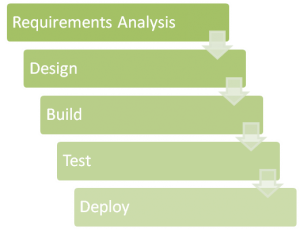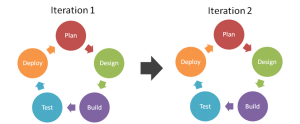In Business Intelligence Demystified Part 1, we discussed the purpose of business intelligence systems: To turn data into decisions that drive improved business performance.
This month we’ll take a look at implementing a business intelligence system quickly using a project management approach called Agile Development.
Agile development is a modern approach to software development that offers several practical advantages over traditional development methods. In traditional development the project moves linearly through the major phases, passing from one phase to the next as each is completed. This approach is often referred to as “waterfall” development as this diagram illustrates
Traditional Development
In contrast, an agile development approach employs a series of development cycles called iterations. Each iteration seeks to deliver functional code and includes
With each iteration, the development team attempts to build a potentially deployable (properly tested) product
Agile Development
Traditional waterfall development depends on a perfect understanding of product requirements at the outset of the project. In practice this is rarely achieved. More often there is a general idea of what the system should do, but many details of exactly how the system needs to work are not known and only become known after the system is developed and tested. The result is often a complete system that functions as specified but does not actually fulfill the need the system was intended to fill.
In the real world, agile development more quickly produces a system that works as intended because of the reality checks that occur with each iteration that expose problems early.
At PC Ware, we employ agile development. We find this allows us to rapidly deliver systems that meet all business requirements. If you have a business intelligence need that could benefit from rapid development, call Zev for a consultation on how agile development could help you.







